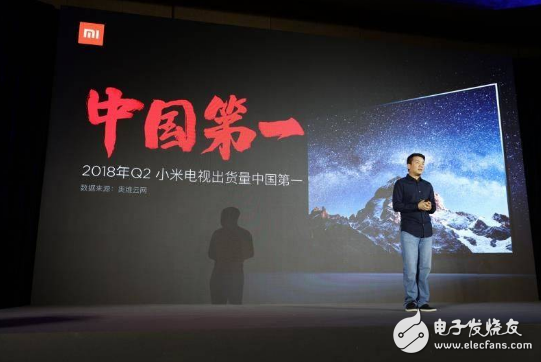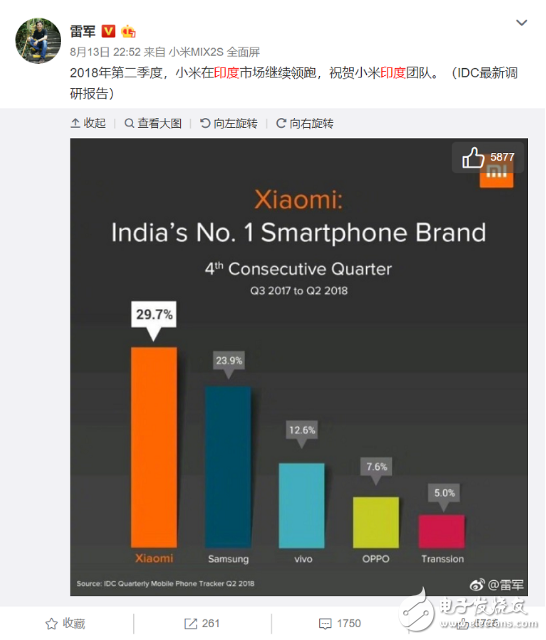In 2018, when the TV industry's growth shrank, Xiaomi became a dark horse.
On May 31st, at the Xiaomi 8th Anniversary New Product Launch Conference, the Mi TV, which appeared as the last link, seemed to be overshadowed by the Mi 8 Discovery Edition. Not many people noticed a message mentioned by Lei Jun-Mi TV became in April. Number of domestic shipments. 1.
In the past three months, at the Xiaomi TV conference on August 28, Wang Chuan, the co-founder of Xiaomi and the head of Xiaomi TV, said that Xiaomi TV has already won the No. 1 shipment in the second quarter of this year and hopes to become 2018 China's TV shipments ranked first in the year, and promised not to increase prices this year.
This goal seems not to be out of reach now, but as a part of Xiaomi's hardware ecology, Xiaomi TV is a new brand that has only been 5 years old since 2013, compared to Xiaomi phones that have grown for 8 years. In the field of black home appliances, Xiaomi TV has to face many traditional and strong home appliance brands. After this journey, it faces no fewer problems than mobile phones.
Why does Mi TV stand out and seize the top spot? What does it mean to be number one? How will the next road go? After the press conference that day, Geek Park interviewed Wang Chuan and hoped to find answers to these questions from his answers.
Rise against the trendDomestic TV manufacturers had an uncomfortable life in 2018. According to data, in 2018, the domestic TV industry growth rate was only 3.6%, and most TV brands experienced a year-on-year decline, while the growth rate of Xiaomi TV was astonishing. Of 312%. This data is not only rising against the trend, it can be regarded as rising.
On August 22, Xiaomi released its first financial report after the IPO, which showed that in the second quarter of 2018, Xiaomi Group’s revenue was 45.226 billion, and the adjusted net profit reached 2.117 billion. It is specific to Xiaomi’s TV business. In the second quarter, global sales increased by 350% year-on-year, and online business remained strong. During the 618 period, Xiaomi TV won the first place in sales and sales on both JD and Tmall platforms.
Wang Chuan said that the reason for this is that Xiaomi TV relies on three labels: quality, innovation, and high cost performance. He took the fastest-growing Mi TV 4A as an example. This 32-inch TV was released in July 2017. The official price of 1,099 yuan attracted almost everyone’s attention. In fact, it did live up to expectations. The sales volume was only 8 months after the launch. More than one million units.

One million units, this sales volume may not be a big deal to the mobile phone industry, but in the TV industry, the sales volume of one million units is undoubtedly considered a hot product (this is still the product still on sale). What's more surprising is that in October 2017, when the product was in short supply, Wang Chuan announced that the price of this TV was reduced by 100 yuan, and the TV entered the ranks of 100 yuan.
The price/performance ratio seems to be a strategy that Xiaomi has always been good at, but there is something intriguing behind this. At the price of 999 yuan, Xiaomi TV 4A also controls the repair rate at 0.64%. Wang Chuan told us that since the beginning of mass production, this TV has a much lower repair rate than the industry as a whole, even for products within 1,000 yuan. , Xiaomi also hopes that it guarantees good enough quality.
China is a populous country, and there are not a few companies that rely on demographic dividends to make money. Wang Chuan also mentioned that profits are nothing more than unit prices and sales. Goods with high unit prices or large sales can make profits. For Xiaomi, it is natural to move towards the latter, but to fight it out among TV manufacturers, the price-performance ratio alone is not enough to support the product going forward. In the domestic smart TV war, most manufacturers have embarked on this road, but Wang Chuanhe Xiaomi TV has taken out another weapon-product innovation.
Smart TV, which seems to be a mainstream product category that people are accustomed to buying TVs today, but in 2013, the node that Xiaomi TV has just appeared, this category accounts for a negligible proportion. At that time, the products that were the main selling point of smart TVs did not have a good user experience.
Xiaomi TV first found a breakthrough-the remote control. The complex and useless design on the traditional remote control was eliminated. The team designed an extremely convenient 11-key remote control, which cooperated with its own TV system to successfully make Xiaomi TV stay on the market. Enough vivid impression. Since then, Xiaomi TV launched the artificial intelligence TV system PatchWall (puzzle wall) in 2017, and the interface of the waterfall flow with the personalized display of data has also made many people see the good use of Xiaomi TV.
Affixed with three unique labels, it took five years for Xiaomi TV to finally open up the pattern of the TV industry, not only the 32-inch Mi TV 4A, but also through the 32-inch, 40, 43, 50, 55, 65, 75-inch product line coverage With this strategy, Xiaomi finally stood at the top of sales, and in the next step, Wang Chuan wanted to sink Xiaomi TV in China and expand overseas.

"What is the biggest challenge today? It is channels. If there are good products, but no channels can not reach users, users don’t know the products are good, and they can’t buy products. I still have to buy products with poor quality and expensive prices. I also ran to the township and the quality of the products they bought was very poor."
Wang Chuan, who won the number one in the quarter and number one online, said frankly that in the second half of the year, the focus of Xiaomi TV in China will be offline. From the perspective of Xiaomi's current product channels, it is mainly concentrated in the first, second and third tier cities in China. People in the fourth and fifth tiers cannot buy Xiaomi TVs. These areas are opportunities and problems.
"We want to go to townships and towns." He said, "There are probably 40,000 spots in towns and townships. If you go to the county town, it will take about 5,000 (Xiaomi’s home). As part of Xiaomi’s many product lines, Xiaomi TV will not be alone. Channels appear, Xiaomi products are integrated, there are mobile phones, smart home products, and will not specialize in opening stores that only sell TVs. Therefore, the difficulty of sinking channels is greater than that of traditional TV manufacturers, which is why it is necessary to find The reason for the dealer."
However, Wang Chuan also mentioned a core point. The dealer channel that Xiaomi is trying to establish should be at the same price online and offline. “No matter how poor the place, the price is the same.†This means that Xiaomi will be operating in offline channels. It is necessary to explore opportunities to ensure dealers' profit. This is not easy, although he said that Xiaomi hopes everyone can make more money:
"To be a company, we are not opposed to profitability. We are neither opposed to our own profitability nor to dealers' profitability. I also hope that everyone can make more money, but we can't make ill-intentioned money, and we can't catch a customer to death. This is what we oppose. Our hardware limits our net profit margin and cannot exceed 5%. We are also a listed company, audited by PricewaterhouseCoopers. If it exceeds 5%, we will send it out. At the end of last year, we already sent it once (with shopping coupons). In the form of). If you earn too much money, you will give it to consumers. Last year, coupons were issued to every user who bought Xiaomi."
China’s next stop in the country is rural villages and towns, and the same is true for overseas planning. After a year or two of quietly growing in India, Xiaomi has already won a lot of victory in India with its mobile phones. In Counterpoint's market survey in December 2017, the overall domestic mobile phone industry shipments fell by 32.5% year-on-year. However, Xiaomi shipped 60 million units in the first half of 2018, and the second quarter increased year-on-year. 43.9%, of which the most critical growth came from overseas, which rose 151.7% year-on-year, accounting for 36.3% of revenue.

India is the most important overseas market for Xiaomi. Wang Chuan mentioned that the most important point for Xiaomi's choice here is the population. The Xiaomi mobile phone that opened up the market in India undoubtedly laid a good foundation for Xiaomi TV. In the rapidly developing Indian market with a large population, the overall environment of the TV industry determines Xiaomi's advantages.
"There are two types of Indian TV manufacturers, much like China ten or twenty years ago. China is also two types of manufacturers. One type of manufacturer is a foreign brand, the other is a local brand, and Indian brands are all based in China. Produced, once I went to their home appliance repair company and saw that many TVs and many brands were dismantled from the same supplier in China, and they were exactly the same. The only difference is that the label is different, which is who posted it. Mark."
Wang Chuan said that almost all local brands in the Indian TV market are made in China, and overseas brands are expensive Samsung, Sony, and LG. Under such an environment, the advantages of Xiaomi TV in products are obvious. He believes that quality + price + content are the weapons of Xiaomi TV. Because TV and mobile phones are different, TV needs to meet local content needs in various countries, so Xiaomi covers almost all TV content in India, and it is not too much to describe it as the "king of content".
Wang Chuan said that in the Indian TV market, almost all 55-inch TVs of foreign brands start at RMB 30,000. The opportunity for Xiaomi TV is here. Before entering India, smart TVs in India accounted for less than 10% of the overall TV industry. After Xiaomi TV entered India this year, it has now become a boom.
India’s July data shows that Xiaomi TV has won 56.6% of the platform’s market share, and Xiaomi’s overall TV market share in India has exceeded 10%; even a Sri Lankan brother has to take the Xiaomi TV home by plane. This shows its overseas popularity, and this also gives Xiaomi TV a greater outlook. The next step is to set up more Xiaomi homes and factories in India.
In addition, Wang Chuan revealed that Xiaomi will soon release TV in Indonesia. The positive response from the Indian market has given the team a lot of encouragement. Xiaomi has the opportunity to enter the overseas TV market with a Chinese brand, and also has the opportunity to find new in the smart TV business. Opportunity, he hopes that Xiaomi TV will become the leader:
I personally think that the next ten years will be the ten years for the rise of Chinese brands. A large number of Chinese global brands will also be born in China. I believe that Xiaomi is not the only one, and there will be other brands. I hope everyone will go overseas together. This is China’s biggest brand. The Age of Navigation. We hope that Xiaomi can be the leader, we rush out first.
Capillary Of Thermometer,Bourdon Gauge Thermometer,Capillary In Thermometer,Thermometer Pressure Gauge
ZHOUSHAN JIAERLING METER CO.,LTD , https://www.zsjrlmeter.com
